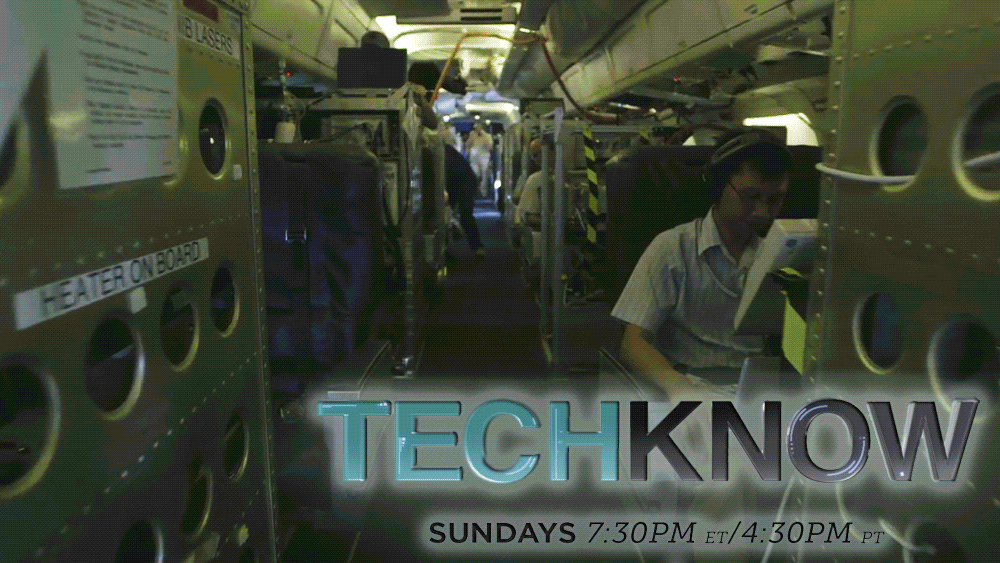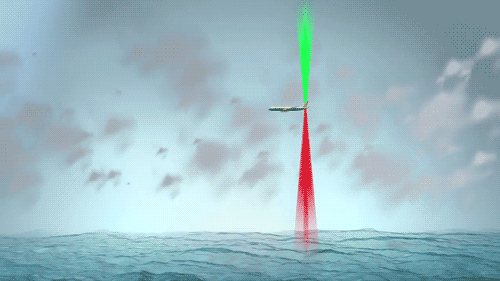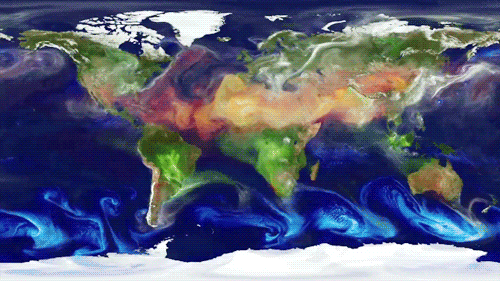NASA's airborne lab gathers more detailed climate data than satellites
On this week’s “TechKnow,” Phil Torres goes airborne to learn more about a NASA program called SEAC4RS (Studies of Emissions and Atmospheric Composition, Clouds, and Climate Coupling by Regional Surveys) and a fleet of jets that are being utilized as flying laboratories to study pollution, climate change and the atmosphere.
"I like science laboratories enough as it is," “TechKnow” contributor Phil Torres says, "but to be in the air and be in a science lab -- it was pretty cool."

“An aircraft, unlike a satellite, is steerable,” Mission Director Walter Klein tells Torres. “We can find a structure and repeatedly fly over it manually, and really get to know on the micro-level over a broad area of ground what’s happening.”
The SEAC4RS program flies three times a week, employing three different types of aircraft that fly in formation, taking readings from varying altitudes at the same locations. Probes and instruments on the exterior of the planes collect samples and measure conditions as they fly on a designated path.

A NASA DC-8 provides observations from the surface up to 12 kilometers (about 7.5 miles) and carries scientists and equipment to conduct tests and collect samples in the air. Torres catches a ride on the airborne laboratory and talks to the scientists who are gathering data to study weather, atmosphere, and most specifically, climate change.
"The job of the plane is to conduct the symphony of the science on the aircraft, making sure that the scientists are getting what they need when they want it, how they want it,” Klein explains to Torres. “We’re also making sure we’re doing it safely.”
It may look like a commercial jet, but activity inside the DC-8 is nothing like passengers are used to. The scientists are in charge, telling the flight crew where to fly and at what altitude. They seek out clouds and areas of turbulence, making for a bumpy ride. They also instruct the pilot to circle back through areas of interest, sometimes making multiple passes over a specific location.
A NASA ER-2 (modeled after the U-2 spy plane) flies above the DC-8, providing high-altitude observations and samples from the lower stratosphere and sending them to Mission Control on the ground. A Learjet conducts cloud measurements and communicates with the other planes, as well as with coordinated satellites that fly in orbit above the planes’ paths.
Jasna Vellovic Pittman is a research scientist from Harvard University. She works with a team that studies information gathered from an instrument on the ER-2.
“Almost no other plane is capable of of reaching these high altitudes,” Pittman tells Torres. “We have remote sensors that allow us to look at the chemical composition of the atmosphere, the outflow of convective activity... We’re also interested in looking at the effects of hurricanes.”
The mission on the day of Torres’ flight takes them over the Gulf of Mexico, testing convection in the clouds and measuring pollution levels. The DC-8 can drop down to as low as 300 feet over the Gulf’s waters, allowing the plane to fly directly over ships and oil rigs so the scientists can measure their emissions. To test cloud convection, the plane also flies in a slow vortex up to 40,000 feet to measure emissions at varying altitudes.
Inside the DC-8’s flying laboratory, the scientists operate spectrometers, lasers, collection tanks, and more to gather information about individual pieces of the atmospheric puzzle. They send their data scientists on the ground at Mission Control who track flight paths via radar and communicate with scientists in the sky.
NASA Senior Research Scientist Syed Ismail operates the multi-directional diode laser that collects data by shooting a beam up from the DC-8 into the atmosphere as well as down to the earth’s surface. Readings from the laser are used to measure gases and ozone distribution.
“The amount of CO2 in the atmosphere is historically very high,” Ismail explains. “The rate of change is unprecedented...We are seeing indications of warming. The melting of the polar ice caps is one indicator. Even global temperatures from now compared to 20 years ago are slightly higher.”
Nicola Blake’s station on the plane collects air samples to be shipped back to her lab, where she will test for different gases in the atmosphere.
“We always find certain hydrocarbons: methane, ethane, all the way up to benzene and toluene,” Blake tells Torres. “A lot of those gases come from car exhaust. They build up over many years. Methane has a lifetime of about ten years, so even if we stopped emitting methane today, all over the planet, we would still have a lot of methane.”

A animation of how the laser reads both above and below an aircraft.
Pollutants like methane not only increase temperatures and contribute to climate change, Blake explains, but also change the physical structure of the atmosphere. Like Ismail, she is concerned that human pollution is accelerating the negative effects of climate change.
“We’re just throwing things into [the atmosphere],” she tells Torres. “We’re using it like a trash can.”
While efforts to curb CO2 emissions are becoming more popular as climate change awareness increases, there are always new dangers to the atmosphere that scientists must track and study. Torres sees this first-hand when the planes fly over Texas to measure methane levels above oil fracking fields.
Benjamin Nault operates a laser that measures the substances in the air over the fracking fields as well as ozone production.
"It’s still unknown how much greenhouse gases and other gases are being emitted by the fracking fields,” Nault explains to Torres. “[Fracking emissions] can contribute to the greenhouse gases.”
Nault notices a clear spike in nitrogen dioxide as the DC-8 passes over the area, but the understanding of fracking’s long-term effects on the atmosphere is just beginning.
“There have been studies trying to understand this in the Utah and Colorado basins because they’ve been seeing ozone exceedances during the wintertimes,” he tells Torres. “We’re thinking that’s from the fracking fields.”
Principal investigator Jack Dibb runs a station on the DC-8 that collects particles (anything larger than 5 microns) from the air.
“What we’re measuring is the ions within those particles,” Dibb explains to Torres. “So they tell us things about different kinds of pollution or sea salt or dust.”
Dibb has flown all over the country in the DC-8, even measuring air quality over over the rim fire in the Sierra Nevada mountains last summer.
“It was nasty stuff,” he tells Torres. “We get excited when we see a couple hundred parts per billion change [in CO levels], and we were seeing factors of a thousand times higher, right in there. Formaldehyde levels were astronomical… It’s bad. It’s a really serious pollutant.”
Over the rim fire, Dibb collected particle samples that were different from anything he had ever seen. With filters on his collection tubes visibly dirty, it was clear that the air quality was incredibly poor.
“The air quality right close to the fire was way higher than probably any urban pollution anywhere on the planet,” Dibb tells Torres. “Anybody that was there breathing that air would probably have reduced life expectancy. It’s like cigarette smoke, just a slew of organic compounds and carcinogens.”
Dibb fears the long-term effects could be even more dangerous.
"There’s a lot of black carbon in the smoke and a lot of organic aerosols,” he explains. “Black carbon on some surfaces is actually going to contribute to climate change warming.”
Dibb is pessimistic about the future of Earth’s atmosphere and the effects that climate change will continue to have on air quality. “I do not have a rosy outlook for what the state of the world is going to be like in fifty or a hundred years,” he says. “There may be some progress, but I’m not terribly optimistic. Countries like the U.S., we are tremendously potent emitters of a lot of bad stuff. We are not doing very much to reduce emissions.”
Dibb fears the problem could get even worse as developing nations that lack regulation continue to pump pollutants into the atmosphere. His team has already seen air particles travel all the way from Asia and across the continental U.S.

Mission Director Walt Klein remains optimistic about the work that his team is doing. With every SEAC4RS flight, the scientists gain more information to better understand the atmosphere and help develop ways to keep it cleaner.
“If we don’t do anything about it, we’re just going to continue on wrecking the earth,” he says.
Watch "TechKnow," Sundays at 7:30PM ET/4:30PM PT on Al Jazeera America.
Error
Sorry, your comment was not saved due to a technical problem. Please try again later or using a different browser.